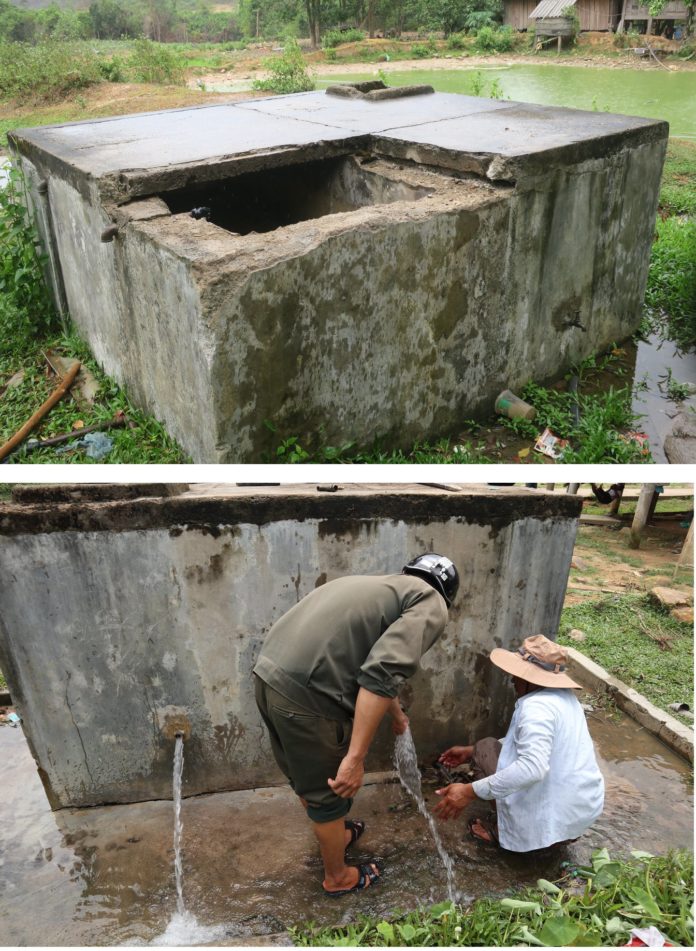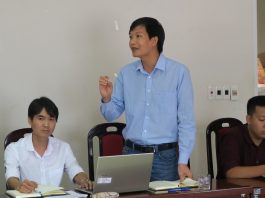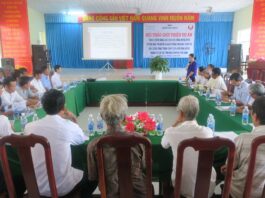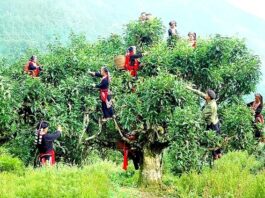“Until now when the project is completed, I believe that we have done it, because initially, the people in our village thought that it could not be repaired. We have proposed suggestions for repairing to all levels for years but it has not been done, as it was believed that the feasibility to operate and maintain this project is unrealistic. If there is a repair, the cost is huge and there is no funding to implement ”- Ms. Ho Thi Men, head of Ta Lao village, Ta Long commune, DaKrong district, Quang Tri province shared with us on the way to visit the water works of the village after being operated and maintained.
Ta Lao village is one of the most difficult villages in Ta Long commune, DaKrong district, Quang Tri province with 89 households (of which 47 poor households and 6 near-poor households), 100% of ethnic minority households – Van Kieu. Villagers mainly live on agriculture and forestry (planting rice, forests and raise livestock). With the characteristics of rocky terrain, the use of drinking water for the people of Ta Lao village depends entirely on the natural supply from the headwaters of groundwater on high mountains. According to the people of Ta Lao village before, when there was no drinkable water, they had to collect water by buckets and carry a far distance or store rainwater, but there was not enough water to use in the dry season.
In 2004, Ta Lao village was supported by the 135 program to invest in the construction of daily-domestic water works to bring water from Ta Lao Trong mountain to the residential clusters of the village. The scale consists of 3km with a-110 zinc water pipeline, with 12 concentrated domestic water tanks and divided into 3 areas: internal Ta Lao, external Ta Lao and central Ta Lao, each zone has 4 tanks, total budget to make the project is nearly 1.2 billion VND. By 2005, the project was completed with the joy the people in the village. Initially, the water flow was stable and fully served all the households in the village and a primary school located nearby. However, only after nearly 3 years of use, the construction began to deteriorate, the headwaters, plumbing, valves and water tanks began to degrade and could not meet the needs of domestic water for local people. Households who can afford to buy plastic pipes themselves carry water from small “mounds” in the mountains, while poor households have to carry water from the source upstream. Villagers said that the construction was damaged due to not regularly maintained, and at the completion of the project, there were no one in the village to manage. Initially, the valves and taps were still good, they were used normally, when the construction started to degrade, people arbitrarily carved holes to take water to their homes, gradually water no longer flowed into the concentrated water tanks, because after only a few years of use, almost half of the tanks were abandoned, the remaining tanks were used by only a few households, and most households had to collect water for their own use.
From 2008 up to now, people of Ta Lao village completely stuck in finding a plan to revive the project. Many times, it has been suggested to the local authorities to repair and maintain but not succeed. In addition to not having proper management and operation, the situation of “Everybody’s business is nobody’s business”, the sense of protecting people’s works is limited, the works cannot be handed over to the units or anyone to manage. This made the construction worse and worse.
Through cooperation with CARE in Vietnam and DEMA Quang Tri, in July 2019, RIC organized a workshop to share experiences in implementing a community-based operation and maintenance (O&M) model in Ta Long commune, DaKrong district. At the workshop, the stakeholders participated in a very open discussion and assessed the relevance of this model to the current situation of local works, then decided to choose the domestic water work of Ta Lao village to pilot the model. Many delegates wondered that repairing this project requires a large amount of funding and complex technique that people could not do, however, people in Ta Lao village are very determined. With the active support from the project, people put effort into repairing the project.
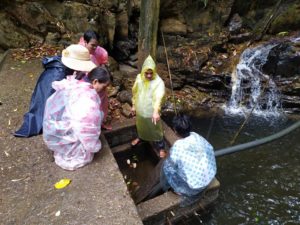
Image 1: Survey the situation of the work
After more than 2 months of implementation, with the support from the project through the activities: survey and assessment to determine the status of the damage of the work, organise technical training on maintenance technique. With a total implementation cost of 52,503,000 VND (€ 1983, (IA supports: 39,003,000 VND (€ 1,473) , people contribute: 13,500,000 VND) (€ 510). People in Ta Lao village have really “revived” the project with 5 concentrated water tanks, providing enough water for 44 households with 207 people (including 23 poor households, 3 near-poor households) and 01 beneficiary primary school with 3 teachers and 29 students. We felt joyfulness on the faces of the people and local authorities on the day we returned. Ms. Ho Thi Hoa – Vice Chairman of Ta Long Commune People’s Committee shared, “This project has been damaged for a long time, and the people’s council meeting in the commune proposed repairing it. But the annual maintenance cost of the project is very small. When appraising, we thought that it could not be repaired, with the amount of several tens of millions VND. But surprisingly, by the project method, under the guidance of the district’s agriculture department staff (who is well aware of the construction work), when surveying, we recognised that we did not need the large amount of money, but the main thing that needs to be surveyed, evaluated in person and assigned to the users to manage and implement. I myself have been being a social worker in the commune for nearly 10 years and I don’t think with small amount of money can fix such a big project. I believe that if we hand over the rights to the people to manage, it will increase the sustainability of the project”.
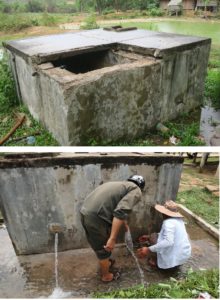
Image 2: The change of the domestic water work before and after maintenance
After the implementation process, at the meeting to share results and lessons learned, the stakeholders highly appreciated the effectiveness of the model. Ms. Nguyen Thi Thuong – Deputy Head of Ethnic policy Department, DEMA Quang Tri said: “I myself have been visiting the water work of the project implemented by RIC in Hoa Binh province. I was really impressed with the project in Khu village, Ngoc Son commune, Lac Son district and proposed RIC to pilot this model in Quang Tri. In fact, I am not too surprised with the maintenance and revitalization of water works in Ta Lao village, because I think if we have a suitable method, it will not be difficult at all. What is important through this model is that we draw valuable lessons and I find that most of the stakeholders agreed that: 1) Trust people; 2) Determination to do, pilot it; 3) Conduct a field survey, we must not sit down to guess the disease. As the Ta Lao village project initially thought that it needed more than VND 100 million, but it only use the project 39 million in reality; 4) Utilize professional commune and district staff who are reputable and active in the village to participate in the project ”. I believe this will be a pilot model in Quang Tri so that other areas can study and replicate ”.

Image 3: Local people and students benefited from the work
At the end of the project visit, the people of Ta Lao excitedly told us, “It is unbelievable that we could revive it, and now we believed we can do it.”

